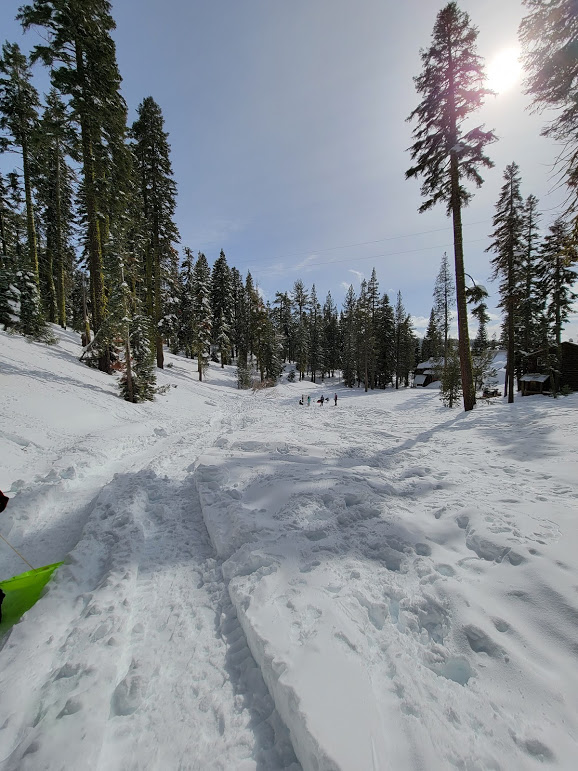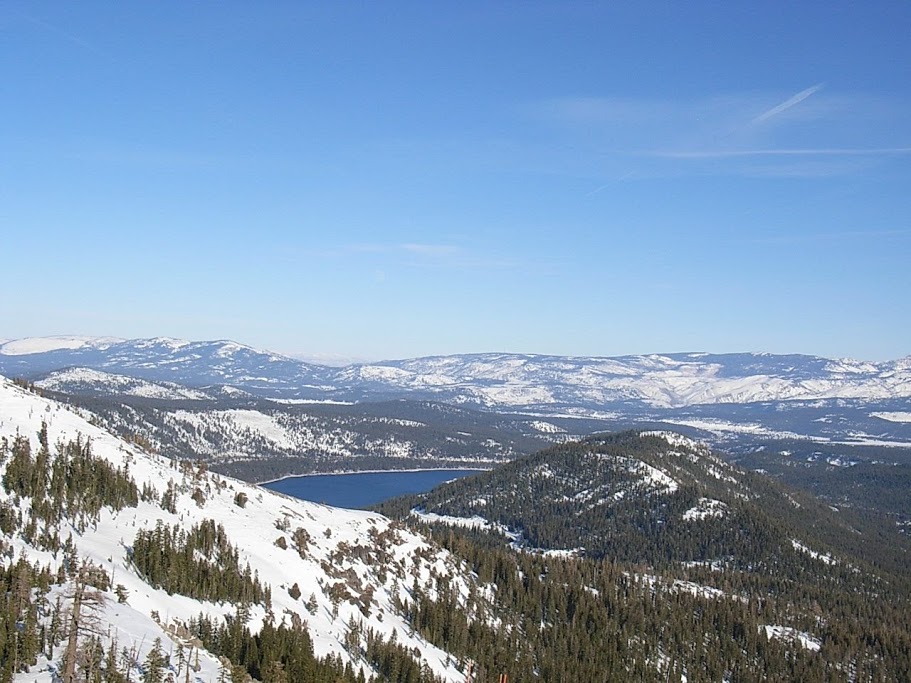I fly quite a bit between San Francisco and Columbus, Ohio. Everytime I do I’m fascinated by the vastness of the country and amazed at how quickly non-Native people spread and populated the land. I think about how the Pilgrims arrived in 1620 and how everything to the west of the Atlantic shore was terra incognita, an unknown wilderness full of rumor, foreboding and mystery. Then just a short 400 years later the descendants of these first colonialists, invaders, immigrants, whatever you want to call them, are everywhere and in such numbers! How did these newcomers spread so quickly!
I think about the ancestors all Americans have who had to say goodbye to their families and homelands, most likely to never see the land or relatives again. They arrive in America, some stay close to the Atlantic while others move farther West given cheap and readily available land. Then over 400 years their descendants spread all over the country. Since commercial flight only recently became available this means many permanent goodbyes pre-1910 as people travel by wagon, train, automobile.
From my 33,000 foot perch in the sky I look down and see endless, empty deserts in the West with only sporadic signs of habitation and I wonder who could possibly live there, or what purpose the building could possibly serve. I see small communities of perhaps 25 houses and let my imagination run wild as to what may go on in those isolated towns. If only there were reliable GPS and internet I would find myself looking up all those small towns and would do so the entire flight. The desolation is followed by vast plains where farmland is everywhere and I wonder what it would be like to live in a farmhouse where the nearest neighbor is two miles away. I wonder if there is a bed and breakfast I could stay at to have the experience of a true American morning on the farm.
Flying over the Midwest the amount of larger cities starts to increase as I get closer to Ohio. I realize one thing I have not seen since passing the Sierra mountains is a vast forest. My history books tell me that America was once covered with forests but I do not see anything that looks like a vast forest in the middle of the country and I cannot help but feel a bit sad. I think of how the settlers tore up everything in the middle of the country for farmland creating the great Dust Bowl.
So, as you can see quite a bit goes through my mind when I look down at the land while flying over the country. It is from this fascination that I was very excited to read this book. I want to truly understand what those times were like. The standard school history books always present the past in dry bland facts, rife with propaganda while usually omitting the difficult parts or not being forthcoming about the truth. I want to understand the past as though I were actually there. I want to hear the first hand accounts from many different viewpoints. I don’t want the fifth grade sanitized version, I want the grit and dirt as well as the great deeds. I simply want to understand the past as it actually was. This book has helped me come closer to understanding what occurred as Europeans took over this land.
My favorite passages with comments:
Strange and wonderous folk were said to dwell in the vastness. Among these were a tribe of man-hating, arrow-shooting Amazons, each of whom had her right breast removed because it got in the way of the bowstring; and a tribe of Welsh-speaking Indians descended from a Briton who had reached the Americas long before Columbus. One particularly bizarre story had it that in an eerie region called Les Cotes Brulees (the Burnt Cliffs) would be found a community of devils in human form standing only 18 inches high.
I’m amazed that that this legend from Spain made its way to the English. Rumors and legends transcend borders and cultures I guess. I’ve written about this before and so as to not have to write it again I’ll reference my previous post.
The book is called “Las Sergas de Esplandian” and is important to us in this post because it is where the name “California” came from.
In the book, there is a fictional island named “California” ruled by a Queen Califa. When the Spanish had made their way across Mexico, they crossed the gulf of California and found Baja California (Lower California). They didn’t know it was a peninsula and thought it was an island. As they had been reading Las Sergas de Esplandian they jokingly named it California.
Mateo de Colón
Now why was the queen named Califa? Califa sounds like Caliphate which is an Islamic word and refers to a system of governance. Therefore, by naming the queen Califa, it gives her a bit of an ominous sound as the Spaniards are very anti-Islam.
Lewis was asked particularly to determine, if possible, any affinities between Indian religions and Judaism – since it was believed by some people that American Indians might actually be the descendants of lost tribes of wandering Jews.
At first blush the modern reader wouldn’t know what to make of this as nobody I know is an expert on the lost tribes of Israel, myself included. Personally I think the idea is best left among historical literature such as the Bible which as Christopher Hitchens says are “plagiarism of a plagiarism of a hearsay of a hearsay, of an illusion of an illusion, extending all the way back to a fabrication of a few nonevents.” My current understanding of humanity is that we all descended from Africa, evolving into slightly different versions over the millennia as our ancestors spread across the globe. Just as I’m fascinated by the spread of immigrants to America across the country I’m also fascinated by how humans crossed the land bridge from Eurasia to the American continent and spread all the way down to Tierra del Fuego! These wanderers formed into distinct tribes with their own features and languages. I think about how a Native is born into the tribe, knowing nothing of how his people actually got there. Living his entire life within perhaps a 100 mile radius, fearful of other tribes,then dying and repeating the process over tens of thousands of years.
Returning to the idea of being a lost tribe of Israel, I had to look it up and apparently some of this belief survives into 2021!
https://en.wikipedia.org/wiki/Ten_Lost_Tribes#Native_Americans
Farther on they would see herds of well over 10,000 buffalo, at times “attended by their shepherds the wolves” or feeding in company with other game “in one common and boundless pasture….the buffaloe Elk and Antelope are so gentle that we pass near them while feeding, without appearing to excite any alarm among them; and when we attract their attention, they frequently approach us more nearly to discovery what we are.”
The Garden of Eden. A place where animals are unafraid of humans and in a state of absolute purity, unspoiled. The Native American was part of nature and lived in harmony with it. It seems that Europeans, with the Industrial Revolution, have been bent on destroying nature.
Sentenced him to run the Gantlet four times through the Party & that each man with nine Swichies Should punish him and for him not to be considered in future as one of the Party.”
Interesting punishment to put a grown man through isn’t it?
the Indian agreed that discipline was necessary but “his nation never whiped even their Children, from their burth.” How then, Clark inquired would the chief have made an example in a similar case? The chief’s advice was simple: kill him.
Although I admire much about the Native Americans It seems that regard for human life wasn’t part of their culture. As I want to understand things as they were this is part of the grit, the part that gets omitted. Natives did go on raids and it was part of their culture. This aspect does lend support to that word “savage.” The white man using that word however is like the pot calling the kettle black. Europeans did plenty of raiding (Vikings anyone?) and with the advance of civilization those raids simply turned into more organized, massive events of death called wars. Wars still continue to this day with the aim being to plunder the resources of other nations (oil). The difference is instead of being upfront about it they simply use different words like “defending our freedom.” So instead of the Indian saying the reason for their raids were horses, plunder and slaves they could simply say “defending our freedom” and I think it would magically not be “savage” to a great portion of modern Americans, mostly Republicans.

Puzzled but clearly impressed by these firm-handed white men, the tribe took to begging and offering women for the explorers’ beds. “A curious custom,” wrote Clark, “is to give handsom squars to those whome they wish to Show some acknowledgments to.” The offers were not always refused, either here or later. Among the Arikaras, Lewis observed that the women were “Handsome and lively and disposed to be amorous.” Clark confided to his diary that he had never seen more friendly and persistend “squars”‘ they were “verry fond of caressing our men.” On one occasion upriver, however, a warrior had second thoughts about the policy; after giving his wife to a Corpsman for one night, he became so enraged when she attempted to stay with the expedition that he threatened to kill her. The woman was promptly returned and her irate husband soothed with presents.
For most of the journey, Lewis felt that it was wisest to allow the men these diversions with Indian women. However, when the Corps reached the Pacific, where the Indians had already encountered other white adventurers and their diseases, Lewis warned against any contact. But several men were infected – one of them by a woman who bore upon an arm the tattooed brand of a former white admirer, “J. Bowman.”
More grit. I was educated in a Catholic school system and they always omitted these historical facts. I grew up with the belief that all throughout history nobody had sex until they were married! Yes, there was the story of Mary Magdalene but she was only one out of maybe three prostitutes throughout history as far as the Catholic school books are concerned. My teachers didn’t elaborate on the subject. And so, I do enjoy learning that there has been promiscuity and sex all over the place throughout history which completely shatters my former Catholic school ingrained image of the past.
I’ve lived in many countries and it is no secret that opposites do attract, that the sense of exoticism often translates into sexual liaisons. Apparently it was no different between European men and Native American women.
The last paragraph of that entry about white adventurers and their diseases is about something that continues to this day. It is well known among your seasoned expatriate to avoid any native women who frequent military bases or hangouts. The part about the tattoo really stirred a sad emotion in me as I have seen this firsthand. There is a bar in Saigon called Apocalypse Now which was the main establishment for foreigners and Vietnamese to party. Most of the women were prostitutes which we quickly discovered because I had never had so many pretty girls take such an interest in me so quickly! I remember one of them had a tattoo on her arm of a white first name, such as Brad or something like that. I thought it very odd but I couldn’t ask her about it as she didn’t speak English. I knew he must be some type of pimp operating in Saigon and I felt very sorry for the poor girl. I wished “Brad” would ride his motorbike headlong into a semi-truck. And I hope “J. Bowman” met his end with an Indian arrow and loss of scalp.
Not that it offers much information but here is an old post from 2005 when I was living in Saigon and mention Apocalypse, “Apo” for short.
Lewis noted with astonishment that in this virgin land beavers swam fearlessly in their streams in broad daylight. One day a buffalo calf followed him about like a pet dog.
Another small piece of information that paints the American wilderness as a Garden of Eden.
Often the trappers bought or otherwise obtained an Indian girl to take to the mountains for pleasure and to perform some of the dirtier winter camp chores. Indian girls were regularly and willingly sold by the tribesmen at rendezvous. The price might be as little as a jug of whiskey or a horse; but one mountain man claimed to have paid $2,000 in beaver skins for a chief’s daughter. In an especially detailed account of the Mandan tribe, the artist and traveler George Catlin listed some fairly standard rates of exchange: “Their women are beautiful and modest . . . and if either Indian or white man wishes to marry the most beautiful girl in the tribe, she is valued only equal perhaps to two horses, a gun with powder and ball for a year, five or six pounds of beads, or a couple of gallons of whiskey.” But even with this sort of companionship, four or five winter months in a smoky, leaky hut must have been a tedious time – a long season of short rations, bitter cold, wet gear and grubby tasks. All in all, there was precious little glamor, less profit and a surfeit of danger in the life of an ordinary mountain man.
This is a nugget of gold that helps me truly understand the reality of those times. How awful it must have lived in those conditions. Would the experience be better or worse than the Native living with her own tribe? I imagine it would be magnitudes worse but I could be wrong. Living day after day with a dirty man in a hovel, at the mercy of the weather. I imagine those extremely cold temperatures with the only relief being an inefficient fire. Sine I’ve spent my entire life with modern conveniences I believe I would catch pneumonia and die if I were subject to those same conditions.
And again, based on my experiences living overseas I have modern stories of a similar vein. This time the venue isn’t Apocalypse but the bar atop the Sheraton Hotel, which I believe is now called The Lounge. This is where higher end prostitutes would gather and I believe had to pay a bribe to be let in. I remember seeing Chinese businessmen dancing with pretty young girls and feeling sad that many of these poor girls would be whisked away into unhappy marriages with men that treated them worse than property. The sad fact is that hordes of other girls will simply be trafficked and instead of bad marriages will end up in horrible brothels. The world can be a cruel and terrible place when you lift up the lid a little. The selling of a Native American girl to a mountain main is the historical version of a practice that is readily available today in many parts of the world.
If a trapper had anything left after buying his supplies, he usually blew it on the local Indian girls.
In effect the trappers worked 11 months for the sake of a debauch at rendezvous. Many of them thought it was worth it. At the rendezvous they found what they had yearned for all year: company, conversation, new clothes, dry shoes, a variety of women, tobacco and booze. For one glorious month they talked, bragged, fought, gambled, fornicated and drank in a mighty exhibit of manliness before, broke and drained, they turned back into the mountains for another perilous year.
I remember hearing the same about cowboys who drove cattle in the old West. They spent months out on the range and when they finally had the chance to go into town they drank, fornicated, fought and raised all kinds of hell. I learned that the towns really didn’t like it when cowboys came to town.
However terrible the trip might be, the trappers had heard rumors of California’s warm winter sun, mission wineries and passionate Mexican girls.
Two of these things are still true of California to this day. At my place it is 60 degrees and sunny almost everyday. The wineries are plentiful and perhaps the best in the world. In my 14 years here I have yet to discover where all the passionate Mexican girls are. I know Mexican girls are filled to the brim with passion and so perhaps it is simply I haven’t been in a relationship with one to get the full benefits as well as brunt of all that passion.
One problem in dealing with these Indians was that they had only a vague knowledge of rifles, hence little fear of them, So, by way of instruction, Walker organized a shooting exhibition in which his men riddled a beaver-skin target and killed a few ducks floating in the lake that protected their rear. The Diggers, though astonished, failed to draw the logical conclusion.
by a great many Indians, mostly naked, and destitute of fire arms, and who subsist upon fish, roots, acorns and grapes. These Indians, unlike, in this respect to any others that I have seen, cut their hair to the length of three inches.
In some of the rocky hills we found water, and occasionally small bands of Indians, who appeared the most miserable of the human race. They were entirely naked, and subsisted upon grass seeds, grass-hoppers etc.
I’m fascinated to read how primitive these “Diggers” and other tribes of areas close by were. In my reading I learned that horses are not native to America and introduced by the Spaniards only 600 years ago or so. Therefore, tribes would have remained within about a hundred mile radius and evolved with minimal external influence. Here we can really see differences in human development and progress with these tribes being at the bottom of the scale.
I here found another tribe of Indians, who call themselves Amunuchiebes. They cultivate the soil, and raise corn, beans, pumpkins and mellons in abundance, and also a little wheat and cotton.
I captured this passage because I was under the impression the Native Americans didn’t farm very much. The idea came from the fact that Natives were not receptive to whites wanting them to stop roaming and instead stay in one spot with farming. This tribe seems to be more of the farming variety.
One night they saw a spectacular meteor shower. “This was altogether a mystery to some of the men,” wrote Leonard, “but after an explanation from Captain Walker, they were satisfied that no danger need be apprehended from the falling of the stars.”
I think the prevailing idea is that historical people were not very bright. This is absolutely untrue and I’ve learned that the ancients especially possessed a great deal of incredible knowledge. However, this passage demonstrates that great civilizations and their aristocrats aside, the common man probably didn’t know very much.
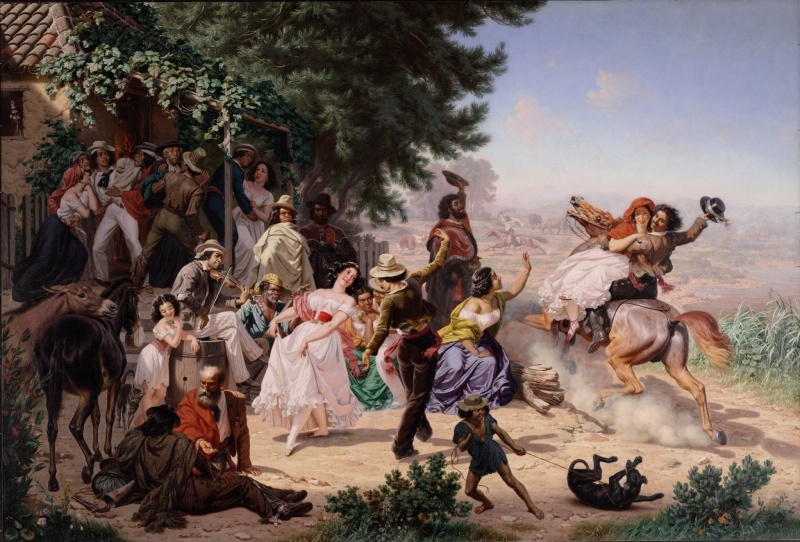
The above image was in the book however there was no elaboration on Fandangos. I’m absolutely fascinated by the idea and can imagine how wonderful these must have been. California is such a vast, isolated land and was sparsely populated before the gold rush. Life would have been so monotonous month after month with even the scenery being a boring vista of dry, brown hills (unless you’re on the coast of course.) So when there was a fandango, a week long party, those must have been what legends are made of. The sheer excitement of seeing other people would be wonderful and then combine that with alcohol, fighting, guns, dancing, amorous liasions and wild west entertainment for an entire week! Well, what a party those must have been indeed. If I had the ability to go back in time attending a fandango would certainly be on my list.
William Drummond Stewart. The second son of Sir George Stewart, 17th Lord of Grantully and fifth Baronet of Murthly…..
He was accepted as an equal by the trappers because he was a superb shot and a durable, enthusiastic hell-raiser who found Indian girls at least as interesting as buffalo.
I thought this was interesting: royalty from the old world preferring life away from all the elite comforts to the severe hardships in a vast wilderness. What an interesting person.
Perhaps the most remarkable – and certainly the most extensive – visual record of the wilderness was that of George Catlin. He came earlier to the West and stayed longer than the others. Also he was as much a scientist, ethnologist and anthropologist as he was an artist, being only of the few 19th Century Americans to systematically observe and record the life style of the Western Indian tribes before they entered their precipitous decline. Catlin brought to his work a profoundly unconventional viewpoint. Almost alone among the Western figures of the time, he believed that the culture of the American Indian was admirable – often equal and sometimes superior to that of the white man – and he devoted much of his life to expressing this belief in both his paintings and writings.
In a Sioux village, for example, Catlin got into terrible trouble when he painted a profile of one warrior. When it was finished, an onlooker twitted the model, saying that the white medicine man had now made him a half-faced man. The gibe touched off a bloody shoot-out. The subject of the portrait was killed, and the entire tribe, in an uproar, began to focus their anger on Catlin. Some white traders interceded and gained the artist enough time to make his escape.
I stumbled upon George Catlin’s works about a decade ago. Again, I love trying to understand the past as it actually was. Catlin’s paintings are the only visual record of what Native Americans actually looked like before their way of life was destroyed by the White Man. This art is absolutely priceless. Here is the official website of his work.
I love a people who have always made me welcome to the best they had . . . who are honest without laws . . . who have no poor house . . . who never take the name of God in vain . . . who worship God without a bible and I believe that God loves them also . . . who are free of religious animosities . . . who never raised a hand against me or stolen my property . . . who never fought a battle with white men except on their own ground . . . and oh! how I love a people who don’t live for the love of money.”
George Catlin
All excellent qualities that, in these regards, are superior to that of the European invaders. Tell me again, who is the “savage?”
At the heart of Manifest Destiny was the notion that the North American continent, from one shining sea to the other, should belong to citizens of the United States. Not only did Americans want and need Western lands but, according to Manifest Destiny, getting those lands was in keeping with the purposes of some higher power – Nature, History or God. National expansion took on something of the nature of a crusade, a holy war that was waged by powerful politicians with the enthusiastic support of much of the electorate.
Of course! God is often the reason for killing, plundering or many other atrocities since humans decided to start worshiping this idea called “God.” Using “God’s Will” for stealing something usually only works for people in positions of power and most often on a grand scale. As far as I know you cannot go into a 7-11, steal something and get away with calling it “God’s Will.” Well, maybe in Alabama.
“Here, on the summit, where the stillness was absolute, unbroken by any sound, and thus the solitude complete, we thought ourselves beyond the region of animated life; but while we were sitting on the rock, a solitary bee (bromus, the bumble bee) came winging his flight from the eastern valley, and lit on the knee of one of the men. It was a strange place, the icy rock and the highest peak of the Rocky Mountains, for a lover of warm sunshine and flowers; and we pleased ourselves with the idea that he was the first of his species to cross the mountain barrier, a solitary pioneer to foretell the advance of civilization.
John Charles Frémont
Pure poetry. Or putting it another way, a bunch of white guys climbed to the top of a mountain without killing themselves in a useless symbolic gesture in a land that had already been populated for millennia. Don’t forget to put a flag and fire a cannon or something.
Since there were so many good reasons for not taking this route, why did Frémont do it? It is likely that he set off across the mountains for much the same reason that he had climbed Fremont Peak, run the rapids on the Platte River and hauled a cannon to Oregon. It seemed to him a dashing, romantic thing to do. It suited his image of himself, and it would enhance his public stature when he told the story in the East.
It isn’t just me being overly cynical, the historians know Fremont was a showboat as well. It is too bad there is a street named for him in San Francisco.
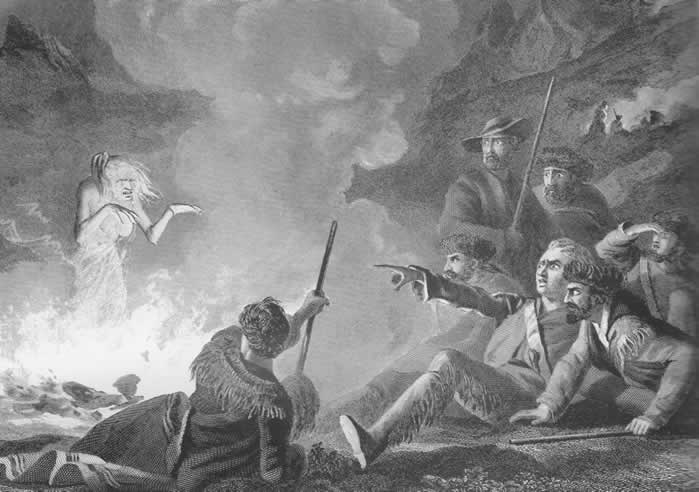
A good supper and a pipe make for them a comfortable ending no matter how hard the day has been. Carson, who was lying on his back with his pipe in his mouth, suddenly exclaimed, ‘Good God! look there!’ In the blaze of the fire, peering over her skinny, crooked hands, which shaded her eyes from the glare, was standing an old woman, apparently eighty years of age, nearly naked, her grizzly hair hanging down over her face and shoulders. She had thought it a camp of her people and had already begun to talk and gesticulate, when her open mouth was paralyzed with fright, as she saw the faces of the whites. She turned to escape, but the men brought her around to the fire.”
Apparently the aged Indian woman had been abandoned by her people because she had outlived her usefulness. Frémont gave her a supply of food and expressed the hope that she would survive through the approaching winter, observing, in his usual optimistic fashion, that “Nut-pines and cedars extend their branches out to the ground and in one of their thickets, as I have often proved, these make a comfortable shelter against the most violent snow-storms.”
Japan also has a history of casting out old women as they were seen as a burden. Their preferred method is to abandon them on a mountain or some equally remote place. It is called “Ubasute” 姥捨て
https://en.wikipedia.org/wiki/Ubasute
He probably crossed them at what was later known as Donner Pass. The passage was made just before the first heavy snows of winter. Only a year later the Donner party, a group of 80 emigrants, took the same route but were caught by blizzards; half of the men, women and children in the party died and some of the survivors resorted to cannibalism before they were rescued.
Driving from the Bay Area to Lake Tahoe on the I-80 will take you past Donner Pass. Driving there in the winter one must always check the weather and be prepared. Those who do not can often end up stuck just like the Donner Party although at worst probably just for a night, with no cannibalism involved. In fact going to Lake Tahoe at all during the winter one should have a 4-wheel drive with mud and snow rated tires and chains are a must. In my video above they closed the I-80 just after we had passed. I was in an Acura MDX with chains on and it was quite tense. As usual, especially in California, there are idiots on the road wanting to go fast and pass everyone. These cars often ended up wrecked into a snowbank and it serves them right. The danger is that the wreck and block the freeway inconveniencing everyone.
The video above gives you an idea how terrible the conditions can be up in the Sierra Mountains during the winter. Now imagine the Donner Party traveling by wagon. That snow would pile up, sometimes in excess of 10 feet high and that’s it, you’re stuck until it melts. How scary it must have been for them to see that snow keep coming down and the sheer terror of having to stop. Then there is the wait as you’re not only frozen day in and day out but also running out of food.
Enemies and critics of Frémont were later to claim that he bided his time in hopes of taking over the rebellion and becoming the founding father of a new nation, like Sam Houston in the Republic of Texas.
Glory seeking Frémont. Why again is there a street named after him in San Francisco? But speaking of streets, here are other characters in the history of California that are easily recognizable as streets in San Francisco.
General Stephen Kearny
Commodore Robert Stockton
John Charles Frémont
John Wesley Powell
Pathfinder (John Frémont) died in a dreary Manhattan boardinghouse, pathetically separated in distance, time and spirit from the days when a young hero had ridden across the prairie with Kit Carson at his side, “caught up in the true Green joy in existence – in the gladness of living.”
Rearing to a height of 13,766 feet, this sheer pinnacle, along with two slightly lesser fellows, had been given their improbably name, Les Grandes Tetones (The Great Breasts), because they had reminded some lonesome, sex-starved French-Canadian trapper of the smooth contours of a woman’s body.
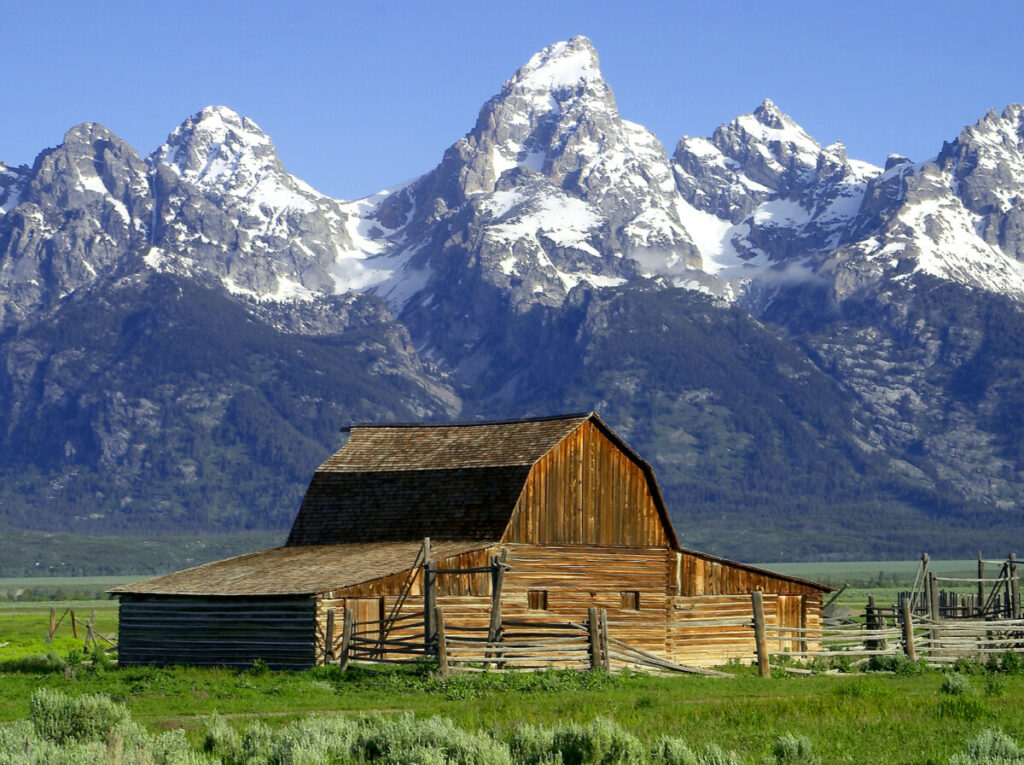
I bet you 99.99% of Americans do not realize these mountains are named for breasts. And even looking closely and for a long time I’m not seeing breasts here. I guess when men go without it for long enough, sexual images could appear anywhere! Kind of like how Jesus appears in toast to delusional Christians.
King established his base camp at Sacramento, preliminary to assaulting Donner Pass and then the Nevada deserts, along a desolate route that Mark Twain later described as a road so littered with the bones of oxen and horses that “we could have walked the forty miles and set our feet on a bone at every step.”
And those bones are still there, just buried and forgotten. How many bones of previously living and now forgotten things we must pass by never knowing they are there. If suddenly the ghosts of living things past could rise out of those bones I doubt there would be more than a few inches of unoccupied space.
A little farther on, the party glimpsed a wisp of smoke and then found “three white men who had been crazy enough to attempt a passage alone to California. They were hanging by their ankles all in a row to a horizontal piñon limb. Their hands were tied behind them and their heads hung to within a foot of the ground and a little fire had been built directly under each head. The skin and hair was burned off their skulls, giving them a ghastly appearance as they swung there perfectly naked.”
The creativeness in ways humans devise to torture other humans seems limitless. It is tough to look in the mirror and realize how primitive of a species we are.
In summary, reading this book has given me such a gift in understanding the history of California. Now, when I drive to Lake Tahoe I think of those mountain men and what it must have been like trekking through the wilderness with none of the modern conveniences. I’ll notice the quiet stillness of the mountain as I ride the ski-lift and try to imagine what it would be like if I were all alone with no civilization around.
History is absolutely fascinating. It is too bad most only experience it in school approved history books.

